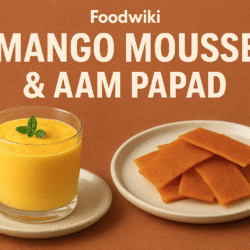
Mango Mousse & Aam Papad
Riddle time! Let’s start with an easy one—what is “Bombay Yellow"? No, it isn’t a paint shade or a fabric dye. Alright, try this: what is “Malda”? And no, it’s not a city either. Let me make it simpler—what connects Safar Pasand, Rajapuri, Raspuri, Chaptai, Rumani, and Neelum? (Here’s a hint: they’re all names for the same beloved fruit.) Still guessing?Then let me give you the obvious ones—Langra, Chausa, Makhi, Sandhuri, Totapuri, and the famous Alphonso.Yes, you got it—mangoes.Often crowned the “King of Fruits,” I sometimes feel “Kanhaiya of fruits” fits better. After all, India alone has more than 200 varieties—each with its own flavour, story, and fan base. I’m sure even Krishna would be amused at how many versions of his favourite fruit now exist.Mangoes are woven into our culture, memories, and celebrations. They’ve always been more than just food. From festivals to daily meals, mangoes and mango leaves play a sacred role across India. Mango leaves tied with a red mauli thread hang proudly outside new homes, shops, offices, and are a part of weddings, ceremonies, and festivals like Deepawali.Modern research tells us what our grandparents seemed to know instinctively—mangoes are rich in potassium, loaded with antioxidants, and may help the body defend itself against heart issues and certain cancers.Come May, the true mango season begins. But to meet soaring demand, many sellers speed up ripening using chemicals like calcium carbide. This powder releases gases that force the fruit to ripen quickly, but the residue can be harmful. Because of this, washing mangoes thoroughly—or soaking them in water for a few minutes—has become essential.Among the many varieties, Alphonso from Maharashtra is often called the world’s best. Much of the premium crop is exported. Honestly, I don’t mind—its shelf life is short, the fruit itself is small, and it’s too pricey for the aam aadmi. My personal favourite is the Andhra Langra: large, thin-skinned, small-seeded, juicy, and wonderfully sweet. Truly value for money.Mangoes find their way into almost everything—pickles, chutneys, relishes, yoghurt, smoothies, lassi, shakes, curries, desserts, and of course, Aam Papad. Just writing this brings back a flood of childhood memories.Every summer, I’d come home from school and find my mother under the blazing sun on the rooftop, drying raw mango slices for pickle. I’d always try to steal a piece to eat later. Our three-storey house offered a view of rooftops filled with raw mangoes drying under the sky—a sight I will always miss.Another vivid memory is summer vacations. Once, while leaving for Shimla, my father packed something unusual—a plastic bucket filled with ice. I wondered if we weren’t staying in a hotel and needed our own bathing bucket! He just smiled and said it was a surprise. Once we settled into the train, he revealed it: a box full of crimson-red mangoes. He gently placed them into the icy water to chill. People around us watched curiously, but he paid no attention. “Let them cool, then we feast,” he declared.The joy of dipping my hands into ice-cold water and pulling out chilled mangoes—eaten the true desi way—was unmatched. No knives, no plates, just hands and happiness. I wasn’t very graceful, and soon I had mango mustaches and juice running down my elbows, much to everyone’s amusement.Soon the curiosity of fellow passengers turned into craving, and as always happens in Indian trains, strangers became friends. Everyone shared, everyone laughed. That old plastic bucket became a part of every summer trip, picnic, and train journey.Kya karein—aam aadmi hoon na.
Ingredients
Mango mousse
- 50 ml lime juice
- Pinch of salt
- 4 lb ripe mango
- 80 Gms granulated sugar
- 1tblsp unflavored gelatin
- 2 egg whites
- 100 Gms heavy cream
Aam Papad
- Fresh mango pulp – 500 gms
- Sugar – 50 gms
Instructions
Mango mousse
- Peel the mangos, slice the flesh off the seeds, and puree in an electric blender with the lime juice, being careful not to over- blend.
- Stir in the sugar.
- Dissolve the gelatin in ¼ cup water. Let it rest for 5 mins. Now just heat the gelatin till it dissolves. Allow to cool and stir into the mango puree.
- Beat the egg whites with the salt until they stand in peaks.
- Whip the cream until it is stiff.
- Fold the cream into the egg whites and then fold this mixture gently into mango puree.
- Pour into a big size serving dish, or into individual dishes, and chill in a refrigerator for 2 to 3 hours, or until set.
Aam Papad
- Mix the sugar and fresh mango puree and start cooking on low heat.
- Cook till the puree becomes very thick and hard to stir. This may take a long time.
- Immediately pour the contents on to a greased tray and spread evenly.
- Keep this in the sun for a complete day. Remove from the edges, cut into bite size to eat.
- P.S. – amount of sugar may vary depending on the sweetness of the mango puree.
Tried this recipe?Let us know how it was!

